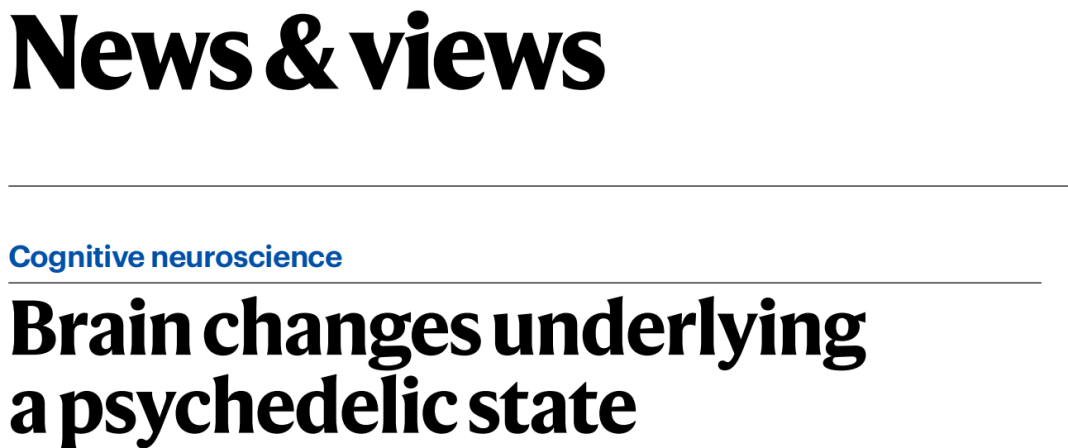When people take psychedelic compounds (psychedelic drugs) such as psilocybin after taking psilocybin, some network connections in the brain, especially those involving self, space, and time perception, dissolve, and these changes in network connections may last for several weeks.
Overview
Psilocybin, the primary active molecule in “magic mushrooms,” is a psychedelic compound that can rapidly alter perception and cognition. Analyzing clinical trial data from the past two decades reveals that when combined with psychotherapy, psilocybin can be used to treat severe depression, addiction, and other mental illnesses. In terms of treatment efficacy, psilocybin not only acts quickly but also has a long duration, often lasting for weeks, months, or even years. However, the specific brain states behind its rapid and prolonged effects are not yet clear. Siegel and colleagues published a paper in the journal “Nature,” analyzing changes in the brains of healthy volunteers after ingesting high doses of psychedelic drugs, providing important insights into the underlying mechanisms.
The human brain is a highly complex organ composed of approximately 100 billion neurons, each of which connects with thousands of other neurons, forming networks that synchronize activity to generate thoughts, behaviors, and emotions.
The brain networks can be roughly divided into primary networks and associative networks. Primary networks are responsible for processing direct sensory and motor functions, for example, the somatosensory network processes touch sensations and coordinates movements, while the auditory network processes sounds. Associative networks participate in higher cognitive processes, integrating information from primary networks to coordinate complex tasks and behaviors. For example, the frontoparietal network and the default mode network, with the frontoparietal network playing a crucial role in decision-making and problem-solving, while the default mode network is responsible for introspection or thoughts about oneself. Together, these networks coordinate the activity of the entire brain to generate normal waking consciousness.
Source: Sara Moser/University of Washington
This heatmap shows the brain transitioning from a resting state (blue and green) to an activated state (red and yellow) after taking psilocybin, gradually returning to normal as the drug wears off.
Experiment
In their study, Siegel and colleagues investigated the effects of psilocybin on brain networks.
Experimental Design:
Using functional magnetic resonance imaging (fMRI) technology, they measured the activity of various brain regions in healthy young people before, during, and three weeks after taking 25 milligrams of the psychedelic drug. During each fMRI scan, participants were asked to remain still and focus on a fixed point for at least 15 minutes while performing a perceptual task to assess whether visual images on a computer screen matched the words they heard through headphones, for example, a beach image matching the word “beach” and a cat image not matching the word “dog.”
Throughout the study, volunteers underwent scans every other day, completing an average of 18 scans, [this longitudinal and repetitive sampling method minimizes the impact of individual differences in brain network organization and studies the effects of psychedelics over time].
Results:
(1) Psychedelic drugs strongly disrupt neural communication throughout the brain. This intense change in neural communication is caused by neuronal desynchronization, reducing integration within networks and isolation between networks, thus blurring the boundaries of brain networks, as shown in the figure;
Figure. Drug-induced functional connectivity changes far exceed daily brain changes
(2) The default mode network is most affected, a network believed to generate self-awareness, spatial perception, and time perception, as shown in the figure;
Figure. Greatest impact of drug on default mode network
(3) Throughout the entire drug administration process, changes in global neural communication are correlated with the intensity of psychedelic experiences, as shown in the figure.
Figure. Changes in global neural communication
Conclusion:
Asynchronous brain activity forms the basis of acute psychedelic states, leading to continuous changes in the neural activity of brain regions responsible for controlling self-awareness, emotions, and life narratives. This holds significant clinical relevance, indicating that psychedelics can make brain connections more flexible, for example, using this flexibility to help addicts perceive their relationship with drugs from a new perspective or to assist depression patients in breaking free from rumination.
Editing: Wu Jinrong
Layout: Yi Wan
Disclaimer: Translation errors may occur, readers are welcome to correct and understand! If something is missing, feel free to leave a comment for addition.


